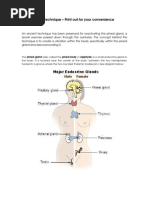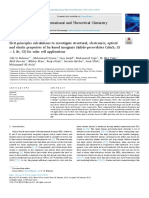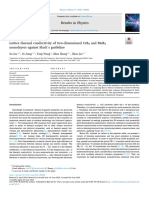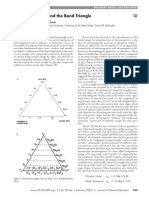Study of Mechanical and Electronic Properties Rare Earth Intermetallics
Study of Mechanical and Electronic Properties Rare Earth Intermetallics
Uploaded by
Anushree AnilCopyright:
Available Formats
Study of Mechanical and Electronic Properties Rare Earth Intermetallics
Study of Mechanical and Electronic Properties Rare Earth Intermetallics
Uploaded by
Anushree AnilOriginal Description:
Original Title
Copyright
Available Formats
Share this document
Did you find this document useful?
Is this content inappropriate?
Copyright:
Available Formats
Study of Mechanical and Electronic Properties Rare Earth Intermetallics
Study of Mechanical and Electronic Properties Rare Earth Intermetallics
Uploaded by
Anushree AnilCopyright:
Available Formats
Study of Mechanical and Electronic Properties rare earth intermetallics (SmX, X=Cu, Zn, Ag, Cd)
SYNOPSIS By Satish Chand For the Degree of Doctor of Philosophy In Physics Submitted to
MEWAR UNIVERSITY GANGRAR, CHITTORGARH (RAJASTHAN) Under the Supervision of
Co-Guide Dr. Rishi Pal Singh
Assistant Professor, Dept. of Physics SSV PG College, Hapur
Guide Dr. Anil Govindan
Associate Professor, Dept. of Physics MMH College Ghaziabad
1. INTRODUCTION During past 2-3 decades, theoretical methods, starting from first principles [1], have become an effective method for the calculation of structural, elastic, mechanical, electronic, magnetic and optical properties of the materials. Such methods are completely unbiased by external inputs, and have been found to predict satisfactory values of the properties which have been sustained or confirmed experimentally. The Density Functional Theory (DFT) [2-5] is one such theoretical approach which provides an appropriate mathematical framework for self consistently determining the ground state properties of the whole system. DFT allows us to determine structural, elastic, mechanical, electronic, magnetic, thermodynamic and optical properties of the macroscopic materials with sufficient accuracy. Modern computational methods reveal deep mutual interaction between the microscopic and macroscopic characteristics of the materials. Using modern methods, based on density functional theory (DFT), it is possible to investigate various parameters of the ideal crystal structure and many other useful characteristics of the materials.
Recently, much progress has been achieved in many metallic / intermetallic / semiconducting (binary compounds as well as alloys) [6-9] materials for device applications and their properties have been experimentally and theoretically studied based on fundamental quantum mechanical description. The efficient computational methods and availability of modern computers of large capabilities have enabled scientists/researchers to calculate many structural, elastic, mechanical, electronic, thermodynamic and optical properties of realistically complex compounds, starting from some basic parameters such as atomic number, bond length, bond angle and crystal structure (for crystalline solids) etc. 2. LITERATURE SURVEY Rare earth intermetallic compounds [10-13] are a class of materials that are often characterized by high melting point, high specific strength, ductility, attractive high temperature mechanical properties, as well as good electrical and magnetic properties, which make them promising high temperature structural materials for automobile, aviation, and aerospace applications [1214]. The high ductility and fracture toughness of intermetallics have made them useful for developing commercial aircraft turbines [15-18]. Some of the properties of intermetallics, say ductility can be modified by making them off- stoichiometric or by doping with a suitable third element [13]. The study
of the rare earth intermetallic compounds represents an important part of the more general problem of the metallic phases, particularly rare earths have peculiar electronic configuration (e.g. electron occupancy in f-shell results valence states etc). As one moves along rare-earth groups in the periodic table, the atomic dimensions and electro-negativities change regularly. Therefore, combining these rare-earth element with transition metals (M: like Cu, Zn, Ag, Cd), interesting results are obtained. The rare earth intermetallics studied in the present proposed work are SmX, (where, X=Cu, Zn, Ag, Cd).
Figure 1.2 Cubic unit cell of (CsCl) type of SmX (R=Sm, X=Cu, Zn, Ag, Cd)
The intermetallics SmX (X=Cu, Zn, Ag, Cd) are known to have CsCl type structure (bcc) which is often referred to as B2 type structure [9-16]. In B2 type cubic crystals, the more electronegative atoms are located at the corners of the unit cell, while the more electropositive atoms are located in the center of the unit cell. The typical crystal unit cell for SmX (R=Sm, X=Cu, Zn, Ag, Cd) is shown in above figure. From the figure, we can see that Cu (or Zn, Ag, Cd) sits at the centre of the cubic unit cell while the rare earth atoms are at the corners. The rare earth binary intermetallics SmX (X=Cu, Zn, Ag, Cd) have space group Pm3m [12-16]. Gschneidner et al., 2003 [13] presented an extensive study on rare earth intermetallics materials which was followed by many more studies [19, 20]. Gschneidner et al., 2003 [13] prepared a number of rare earth intermetallics. The rare earth intermetallics were found to exhibit room temperature ductility. X-ray diffraction, optical metallographic and electron microscopy experiments confirmed the specimens were single-phase with the fully ordered B2 structure [12-23].
OBJECTIVES AND SCOPE Rare earth intermetallics have technological importance in automobile, aviation, and aerospace applications. To best of my knowledge, a lot of properties (magnetic properties, spin properties, Elastic and electronic properties) of some other rare earth intermetallics viz. TbCu, TbZn, [24] GdCu, GdZn [25] have been studies but no mechanical and electronic study of SmX (X=Cu, Zn, Ag, Cd) have been made. Thus, still there is need for a systematic theoretical study of mechanical and electronic properties of these materials for future aspects of applications. Thus, this proposed work is an attempt in that direction. The studies will be carried out to analyze the following properties (a) Mechanical properties: Mechanical properties will be studied in terms of elastic constants (Cij), Bulk modulus (B), Youngs modulus (Y), Shear modulus (G) and Poissons ratio (v). (b) Electronic Properties: Electronic properties will be studied in terms of charge density distribution, density of states (DOS) and band structure.
3. METHODOLOGY Mechanical and electronic properties have been very successful in the study of the physical properties of materials for decades. They give the correct prediction of the physical behaviors of the materials, as well as provide an understanding of the microscopic origin of their properties, which are very helpful for design of the new materials. Thus, in the present research proposal, we will study the Mechanical properties, as well as their electronic contribution behavior at ambient temperature and pressure of Cu, Zn, Ag and Cd based rare earth intermetallics. The study of mechanical and electronic properties of SmX (X=Cu, Zn, Ag, Cd) rare earth intermetallics will be carried out using Density Functional Theory (DFT) within Linearized Full Potential Augmented Plane Wave plus Local orbitals (FP-LAPW + lo) method implemented in WIEN2k package. WIEN2k is an original software package based on UNIX operating system. This software is capable to study the structural, elastic, electronic, optical, thermodynamic, spectroscopic properties of different type of crystalline materials with high accuracy. Thus, in present proposed work the study on elastic, electronic and acoustical properties of crystalline solids will be made using WIEN2k package.
In the first six months of period, some more literature work will be surveyed. During next six month the work function of WIEN2k will be learned. In next one year the proposed work will be carried out and send for publication. In third year the research work will be summarized and thesis will be submitted to University.
REFERENCES
1. Benali K.M., First principles study of structural, elastic and electronic properties of AlN and GaN semiconductors under pressure effect and magnetism in AlN:Mn and GaN:Mn system, Ph. D. Thesis, Abou-Bekr Belkaid University-Tlemcen (2004). 2. Blom A., Density functional theory for beginners, Lund University, Sweden (2002). 3. Becke A.D., Density functional theorem chemistry II. J.Chem. Phys. 97, (1992) 9173. 4. Capelle K., A Birds-Eye View of Density-Functional Theory, University de Sao Paulo, Brazil (2006). 5. Car R. and Parrinello M., Unified approach for molecular dynamics and density functional theory, Phys. Rev. Lett. 55, (1985) 2471. 6. Benayad N., Rached D., Khenata R., Litimein F., Reshak A. H., Rabah M. And Baltache H., First principles study of the structural, elastic and electronic properties of Ti2InC and Ti2InN, Mod. Phys. Lett. B 25, (2011)747. 7. Bouhemadou A., Khenata R., Moaka M., Seddik T., Reshak A.H. and AlDouri Y., FP-APW+lo calculations oe elastic properties in zinc blend III-P compounds under pressure effect, Comput. Mat. Sci. 45, (2009) 474. 8. Chang-Chih C., Electrical resistivity of equiatomic rare earth noble metal compounds, J. Appl. Phys. 37, (1966) 2081. 9. Chao C.C., Luo H.L. and Duwez P., CsCl-type compounds in bainary alloys of rare earth metals with zinc and copper, J. Appl. Phys. 34, (1963) 1971.
10.Gschneidner K.A., Jr. and Eyring L., Handbook on the physics and chemistry of rare earths, Ed. North Holland Publishing Company 5 (1982). 11.Berdovsky Y.N., Intermetallics research progress, Nova Science Publishers, Inc. New York, (2008). 12.Gschneidner K.A., Jr., Russell A.M., Biner S. B., Harmon B. N., Hsu D. K., Lo C.H.C., Lograsso T. A. and Pecharsky A. O. A new paradigmductile intermetallic compounds, U. S. Department of Energy, Basic Energy Science (2005). 13.Gschneidner K.A., Jr., Russell A.M., Pecharsky A.O., Zhang Z., Lograsso T.A., Morris J.R., Hsu D.K., Lo C.H.C., Ye Y.Y., Slager A.J. and Kesse D.C., A New family of ductile intermetallic compounds, Nature Mater. 2, (2003) 591. 14.Oak Ridge National Laboratory Status and Progress Report, Union Carbide Corporation for the U.S. Atomic Energy Commission, (1964) 15.Russell A.M., A Review: Ductility in Intermetallic Compounds, Adv. Eng. Mater. 5, (2003) 639. 16.Russell A.M., Ductility in Intermetallic Compounds, Adv. Engg. Mat. 5, (2003) 629. 17.Russell A.M., Lee K.L., Structure-Property Relations in Nonferrous Metals, John Wiley and Sons, Inc., Hoboken, New Jersey, ed. 1, (2005). 18.Russell A.M., Zhang Z., Lograsso T.A., Lo, C.H.C., Pecharsky, A.O., Morris, J.R., Ye, Y.Y., Gschneidner K.A. Jr. and Slager A.J., Mechanical properties of single crystal YAg, Acta Mater. 52, (2004) 4033. 19.Chernyshov A.S., Tsokol A.O., Tishin A.M., Gschneidner K.A., Jr. and
Pecharsky V.K., Magnetic and Magnetocaloric Properties and the
Magnetic Phase Diagram of Single-crystal Dysprosium, Phys. Rev. B 71, (2005) 184410 20.Pecharsky V.K. and Gschneidner K.A., Jr., Advanced Magnetocaloric Materials: What Does the Future Hold, Intern. J. Refrig. 29, (2006) 1239. 21.Cable W.J., Koehler W.C. and Wollan E.O., Magnetic order in rare-Earth intermetallic compounds, Phys. Rev. 136, (1964) A240. 22.Callister W.D. Jr., Materials Science and Engineering: An Introduction, John Wiley and Sons, Inc., New York, Ed. 5, (2000). 23.Cao G.H., Shechtman D., Wu D.M., Becker A.T., Chumbley L.S., Lograsso T.A., Russell, A.M. and Gschneidner K.A., Determination of slip systems and their relation to the high ductility and fracture toughness of the B2 DyCu intermetallic compounds, Acta Mater. 55, (2007) 3765. 24.Singh R. P., Singh R. K. and Rajagopalan M., First-principle study on structural, elastic and electronic properties of rare-earth intermetallic compounds:TbCu and TbZn. Intermetallics 19 (10), (2011) 1359 25. Singh R. P., Singh R. K., Shalu and Rajagopalan M., first-principle study on structural, elastic and electronic properties of binary rare earth intermetallic compounds:GdCu and GdZn, Int. J. Comp. Mat. Sci. Eng. 01, 1250005 (2012).
You might also like
- Pogil - Periodic Trends RHSDDocument7 pagesPogil - Periodic Trends RHSDErin DodsonNo ratings yet
- Awakening The Third EyeDocument6 pagesAwakening The Third EyeAlejandro94% (17)
- AMIE Material Science Engineering Notes PDFDocument59 pagesAMIE Material Science Engineering Notes PDFSrimannarayana Nandam100% (4)
- Theoretical investigation of structural and magnetic propertiesDocument9 pagesTheoretical investigation of structural and magnetic propertiesAli Raza ShahabNo ratings yet
- Structure and Magnetic Properties of Co Chains On A Stepped Cu Surface PDFDocument12 pagesStructure and Magnetic Properties of Co Chains On A Stepped Cu Surface PDFClovis GuerimNo ratings yet
- Journal of Physics and Chemistry of Solids: 3 2 9 Zia Ur Rehman, M. Awais Rehman, Hamna Chaudhry, Muhammad AwaisDocument8 pagesJournal of Physics and Chemistry of Solids: 3 2 9 Zia Ur Rehman, M. Awais Rehman, Hamna Chaudhry, Muhammad AwaisMuhammad AwaisNo ratings yet
- 6-CsSnX3 (X I, BR, CL)Document7 pages6-CsSnX3 (X I, BR, CL)Muhammad UsmanNo ratings yet
- Double Perovskite HiraDocument14 pagesDouble Perovskite HiraMujtaba AbbasiNo ratings yet
- Crystals 13 00618Document16 pagesCrystals 13 00618Amine El AmriNo ratings yet
- Material Science Notes LatestDocument56 pagesMaterial Science Notes LatestShione T MundawararaNo ratings yet
- Ab-Initio Density Function Theory Electronic Structure Properties of Core and Surface Cdte NanocrystalsDocument11 pagesAb-Initio Density Function Theory Electronic Structure Properties of Core and Surface Cdte NanocrystalsInternational Journal of Application or Innovation in Engineering & ManagementNo ratings yet
- Ce Mo 3Document12 pagesCe Mo 3Tanvir HossainNo ratings yet
- J Intermet 2012 11 022Document8 pagesJ Intermet 2012 11 022ahlamNo ratings yet
- Cs2BB'H6Document12 pagesCs2BB'H6maryaya310No ratings yet
- Resonance PopsciDocument16 pagesResonance PopsciVishwas GuptaNo ratings yet
- Molecular Dynamics Study of The Structural and Thermodynamic Properties of Sio2 Silica During Cooling Between 5000 and 300KDocument19 pagesMolecular Dynamics Study of The Structural and Thermodynamic Properties of Sio2 Silica During Cooling Between 5000 and 300KAnonymous pKuPK3zUNo ratings yet
- Author's Accepted Manuscript: Journal of Physical and Chemistry of SolidsDocument27 pagesAuthor's Accepted Manuscript: Journal of Physical and Chemistry of SolidsJay Bee SharmaNo ratings yet
- Multidimensio... Ta-Structures - Zhipeng ZHENGDocument17 pagesMultidimensio... Ta-Structures - Zhipeng ZHENGhugmelroseNo ratings yet
- High Temperature and Pressure DependentDocument17 pagesHigh Temperature and Pressure DependentAlam KhanNo ratings yet
- Introduction in Materials Science and EngineeringDocument30 pagesIntroduction in Materials Science and EngineeringDennis LingNo ratings yet
- Quarto 2017Document11 pagesQuarto 2017MikeNo ratings yet
- MOSES PROJECT PHYDocument29 pagesMOSES PROJECT PHYKelvin Ekpo InyangNo ratings yet
- First-Principles Calculations To Investigate Structural, ElasticDocument10 pagesFirst-Principles Calculations To Investigate Structural, ElasticFábio MartinsNo ratings yet
- 1 s2.0 S2211379723005351 MainDocument22 pages1 s2.0 S2211379723005351 MainAshir NibirNo ratings yet
- amudhavalli2018Document36 pagesamudhavalli2018Ali Raza ShahabNo ratings yet
- 3d TransitionmetalDocument22 pages3d TransitionmetalSheeza AslamNo ratings yet
- Khansa's Mid Grad Lab ReportDocument19 pagesKhansa's Mid Grad Lab ReportMujtaba AbbasiNo ratings yet
- A Tunable Broadband Filter of Ternary Photonic Crystal Containing Plasma and Superconducting MaterialDocument8 pagesA Tunable Broadband Filter of Ternary Photonic Crystal Containing Plasma and Superconducting MaterialAviral TomarNo ratings yet
- Inorg ProblemsDocument18 pagesInorg ProblemsMark BaronNo ratings yet
- Electron field emission from carbon nanotubesDocument8 pagesElectron field emission from carbon nanotubesRupesh KumarNo ratings yet
- Material Science AnasDocument6 pagesMaterial Science AnasReal MadridNo ratings yet
- Polycrystalline Graphene and Other Two-Dimensional Materials - 16Document38 pagesPolycrystalline Graphene and Other Two-Dimensional Materials - 16Najmul Puda PappadamNo ratings yet
- O P U D M N: Ptical Roperties and Ltrafast Ynamics OF Etallic AnocrystalsDocument41 pagesO P U D M N: Ptical Roperties and Ltrafast Ynamics OF Etallic Anocrystalsgauchio27No ratings yet
- 23022017-090452 CVDocument7 pages23022017-090452 CVEngr Hamid AliNo ratings yet
- Quick-Start Guide For First-Principles Modelling of Semiconductor InterfacesDocument8 pagesQuick-Start Guide For First-Principles Modelling of Semiconductor InterfacesMedo MedicNo ratings yet
- Mehra J 2015Document9 pagesMehra J 2015hussanmuhammadNo ratings yet
- Em NGH Là B T Này I VÌ Mình Ki M Tra Tính N NHC Acácv Tli U Còn V Tli U Có Mô Un Ành Inh Có Tính FlexibleDocument18 pagesEm NGH Là B T Này I VÌ Mình Ki M Tra Tính N NHC Acácv Tli U Còn V Tli U Có Mô Un Ành Inh Có Tính Flexiblesonnguyenminh1997No ratings yet
- Proforma Synopsis For Ph.D. in Science (Physics) : 1. Name of The Project and Title of The ThesisDocument4 pagesProforma Synopsis For Ph.D. in Science (Physics) : 1. Name of The Project and Title of The ThesisalokNo ratings yet
- HSE06 y TB MBJDocument9 pagesHSE06 y TB MBJMenjamin SalasNo ratings yet
- Structural, Elastic, Electronic and Thermoelectric Properties of Xas (X Ca, SR) Binary CompoundsDocument16 pagesStructural, Elastic, Electronic and Thermoelectric Properties of Xas (X Ca, SR) Binary Compoundsadnane adnaneNo ratings yet
- Inner Relaxations in Equiatomic Single-Phase High-Entropy Cantor AlloyDocument31 pagesInner Relaxations in Equiatomic Single-Phase High-Entropy Cantor Alloyhk esatonNo ratings yet
- 1-s2.0-S2772949423000372 FePS3-mainDocument5 pages1-s2.0-S2772949423000372 FePS3-mainJihane AlouiNo ratings yet
- DFT3Document8 pagesDFT3meghnad0110No ratings yet
- 5. Prediction of Mechanical, Electronics and Optical Properties of Monolayer 1t Si-Dichalcogenides via First-Principles TheoryDocument16 pages5. Prediction of Mechanical, Electronics and Optical Properties of Monolayer 1t Si-Dichalcogenides via First-Principles TheoryTrần Thế QuangNo ratings yet
- 1 s2.0 S0039602802018095 MainDocument10 pages1 s2.0 S0039602802018095 MainEwerton ferreiraNo ratings yet
- 1 s2.0 S0254058424001743 MainDocument13 pages1 s2.0 S0254058424001743 MainTuấn Anh PhạmNo ratings yet
- Relation Between N and Band GapDocument8 pagesRelation Between N and Band GapK.SUBRAMANINo ratings yet
- 1 s2.0 S2211379723004898 MainDocument7 pages1 s2.0 S2211379723004898 MainvishaliNo ratings yet
- Au2-13, Deka2008Document11 pagesAu2-13, Deka2008ht117No ratings yet
- Engineering Materials Lec Notes Iprc KigaliDocument195 pagesEngineering Materials Lec Notes Iprc KigaliAlexis MUHIRWANo ratings yet
- Electronic Structure of Quantum Dots: Stephanie M. ReimannDocument60 pagesElectronic Structure of Quantum Dots: Stephanie M. ReimannSrramNo ratings yet
- 1 s2.0 S0927025622005845 MainDocument10 pages1 s2.0 S0927025622005845 Mainsonnguyenminh1997No ratings yet
- Structural, Electrical and Magnetic Properties of Co-Cu Ferrite NanoparticlesDocument8 pagesStructural, Electrical and Magnetic Properties of Co-Cu Ferrite Nanoparticlesehagar60No ratings yet
- SRM University Nano MaterialsDocument37 pagesSRM University Nano MaterialsVikram JainNo ratings yet
- 10 1016@j Physe 2019 02 005 PDFDocument29 pages10 1016@j Physe 2019 02 005 PDFAna LuizaNo ratings yet
- Structural, Magnetic and Dielectric Analysis of Higher Magnetic MN Doped ZN-CR Oxide NanoparticlesDocument10 pagesStructural, Magnetic and Dielectric Analysis of Higher Magnetic MN Doped ZN-CR Oxide NanoparticlesIJRASETPublicationsNo ratings yet
- BIAN - Covalent 2D Cr2Te3 FerromagnetDocument9 pagesBIAN - Covalent 2D Cr2Te3 FerromagnetParvati KaleNo ratings yet
- Mathematical Analysis of Deterministic and Stochastic Problems in Complex Media ElectromagneticsFrom EverandMathematical Analysis of Deterministic and Stochastic Problems in Complex Media ElectromagneticsRating: 5 out of 5 stars5/5 (1)
- Latex For Complete Novices Beginners BookDocument159 pagesLatex For Complete Novices Beginners Bookimran58175No ratings yet
- RESUME Sukhbinder RaitDocument4 pagesRESUME Sukhbinder RaitAnushree AnilNo ratings yet
- From Big BangDocument4 pagesFrom Big BangAnushree AnilNo ratings yet
- CBSE Class 12 Chem Notes Question Block Elements PDFDocument28 pagesCBSE Class 12 Chem Notes Question Block Elements PDFThiru98No ratings yet
- Redox+Reaction+Class+ 11+Vedantu+JEEDocument113 pagesRedox+Reaction+Class+ 11+Vedantu+JEETech Bharat100% (1)
- Unit v - Borides 2024Document7 pagesUnit v - Borides 2024Sandeep SinghNo ratings yet
- 7 Oxidation-Reduction 1205Document17 pages7 Oxidation-Reduction 1205nurnaimsouravNo ratings yet
- 1.4 BondingDocument29 pages1.4 BondingIlincaVasilescuNo ratings yet
- Periodic Properties - Part 3Document38 pagesPeriodic Properties - Part 3Bhavesh GargNo ratings yet
- Topic 3 Periodicity SLDocument21 pagesTopic 3 Periodicity SLLyv SantosaNo ratings yet
- Structure and Reactivity of Organic MoleculeDocument36 pagesStructure and Reactivity of Organic MoleculeAppleNo ratings yet
- Lecture 6 Resonance PDFDocument67 pagesLecture 6 Resonance PDFngwaNo ratings yet
- General Chemistry The Essential Concepts 7th Edition Chang Solutions ManualDocument23 pagesGeneral Chemistry The Essential Concepts 7th Edition Chang Solutions Manualaffableamassor7h7100% (25)
- Classification of Elements and Periodicity in PropertiesDocument64 pagesClassification of Elements and Periodicity in PropertiesLakshanaNo ratings yet
- Chem 109 SlidesDocument321 pagesChem 109 SlidesxchbkrzqktNo ratings yet
- IB Chemistry (Periodic Table)Document1 pageIB Chemistry (Periodic Table)hyunjinp0107No ratings yet
- CH 10 HydrogenDocument33 pagesCH 10 HydrogenRobiatuladawiyahNo ratings yet
- THE P - Block Elements-Anil-Hsslive PDFDocument19 pagesTHE P - Block Elements-Anil-Hsslive PDFKochuzNo ratings yet
- Notes Chemistry DLP F4Document79 pagesNotes Chemistry DLP F4Aleisha SofeaNo ratings yet
- Chapt 02Document17 pagesChapt 02Jesse McClureNo ratings yet
- Sma Negeri 3 Semarang: Lesson PlanDocument7 pagesSma Negeri 3 Semarang: Lesson PlanRirin AlchinNo ratings yet
- Chapter 1 - General Chemistry ReviewDocument24 pagesChapter 1 - General Chemistry ReviewbooboyoyoNo ratings yet
- Chemistry of S P Block ElementsDocument119 pagesChemistry of S P Block ElementsSurender DilipNo ratings yet
- Regents Chemistry - Mr. Lin Master Outline Unit 1 - Atomic StructureDocument58 pagesRegents Chemistry - Mr. Lin Master Outline Unit 1 - Atomic StructureAdair ContemareroNo ratings yet
- And Lue ISBN Test BankDocument59 pagesAnd Lue ISBN Test Bankrobert100% (36)
- Electronegatividad Leland C. AllenDocument12 pagesElectronegatividad Leland C. AllenJuan JoNo ratings yet
- 18thapril Chloe Part2Document8 pages18thapril Chloe Part2Sonia GawadeNo ratings yet
- Module 4 Chemical BondingDocument23 pagesModule 4 Chemical BondingJulie Anne Manggurit (Grade-10 Tesla)No ratings yet
- Class 9th. Che-WPS OfficeDocument4 pagesClass 9th. Che-WPS Officemr467051No ratings yet
- Unit 5 - Test Questions Humss 1 & Abm 3Document9 pagesUnit 5 - Test Questions Humss 1 & Abm 3Neil GabatoNo ratings yet
- CBSE Class 10 Science Chapter 5 NCERT Solutions 2022 - Free PDFDocument7 pagesCBSE Class 10 Science Chapter 5 NCERT Solutions 2022 - Free PDFMuzafar ahmadNo ratings yet
- Electronegativity and The Bond TriangleDocument9 pagesElectronegativity and The Bond TriangleKSmklNo ratings yet





























































































